Huaqing Hot Spring (华清池), also known as Huaqing Palace (华清宫), is a grand and magnificent historical site nestled against the mountainside overlooking the Wei River in China. Originally named “Tangquan Palace” and later renamed “Wenquan Palace,” it earned various titles throughout history, including “Lishan Palace,” “Ligong,” and “Xiu Ling Palace.” Its construction dates back to the early Tang Dynasty, but it reached its zenith during the reign of Emperor Xuanzong.
Emperor Xuanzong dedicated great effort to the expansion and beautification of Huaqing Palace. He frequented the palace almost every October, returning to Chang’an at year’s end. However, with the outbreak of the An Lushan Rebellion and the subsequent turmoil in Chinese politics, the splendor of Huaqing Palace waned rapidly. Subsequent emperors visited it less frequently.
Throughout the dynasties, there were efforts to maintain and repair the palace, but by the time of the Chinese Liberation, the once vibrant hot spring retreat had fallen into disrepair, with its pools and palaces in a state of neglect.
Table of Contents
- Basic Information
- Location and Transportation
- Highlights of Huaqing Hot Spring
- Map and Recommended Routes
- Vlog about Huaqing Hotspring
- What to Do at Huaqing Palace
- Photography Spots and Tips at Huaqing Palace
- Popular Restaurants near Huaqing Palace
- Useful Tips Summarized from Reviews
- Facts about Huaqing Palace
- Other Palaces in Xi’an
Basic Information
| Telephone Number | 0086-029-83812003 |
| Estimated Length of Tower | 1-2 hours |
| Opening Hours | 7.30 – 18.00; Last entry: 17.40 (1st January – 9th September) 7.30 – 17.00; Last entry: 16.40 (10th September – 31st December) |
| Ticket Price | Adult: 120 yuan Children under 6 years old or below 1.2 meters: free Senior citizens above 65 years old: free adolescent between 6 and 18 years old: 60 yuan |
Location and Transportation
Huaqing Hot Spring, is located in Lintong District, Xi’an, in the Shaanxi Province of China. It is situated at the northern foot of the Lishan Mountain Range, approximately 30 kilometers east of the city center of Xi’an.
Bus: Take Lingtong 601, 602, or 613 or Tourist Line 5 or 396, get off at Huaqingchi Stop (Huaqing Hot Spring), walk about 50 meters to the south to reach the entrance.
Subway: this is the most convenient way to get to the pool. Take subway line 9, get off Huaqingchi Station (Huaqing Hot Spring), and the entrance is right to your south.
Highlights of Huaqing Hot Spring
Huaqing Palace Site Museum
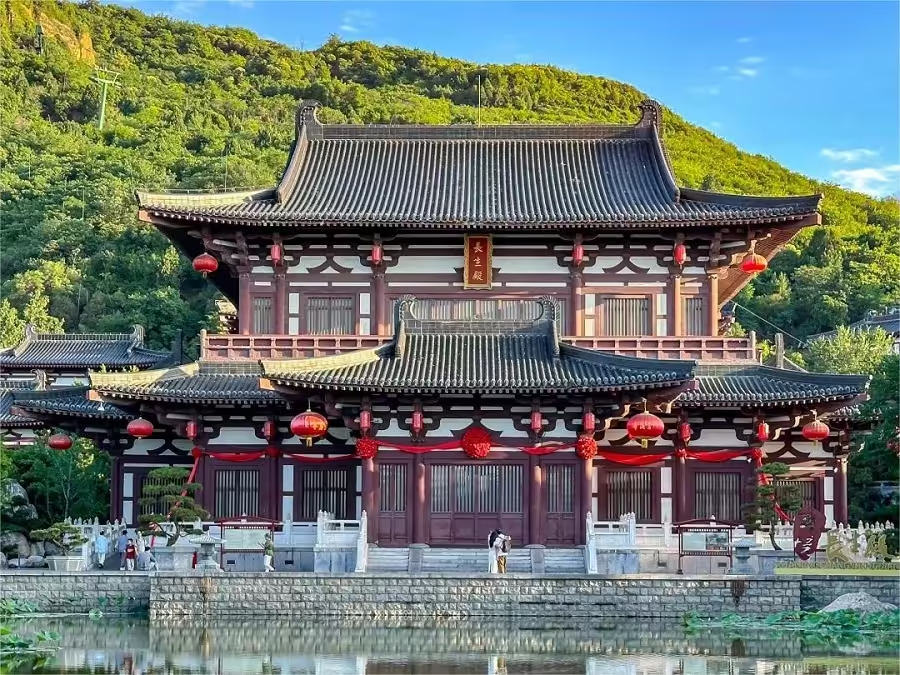
Located in the southwestern part of Huaqing Palace, the Huaqing Palace Site Museum is the only museum in China dedicated to showcasing the Tang Dynasty’s royal bathing pools. Discovered in April 1982, the Tang bathing pool ruins were excavated over three years. The excavation revealed five royal bathing pools used by Emperor Xuanzong and Yang Guifei, including “Lotus Pool,” “Begonia Pool,” and “Stellar Pool,” as well as “Crown Prince Pool” and “Imperial Kitchen Pool.” Over 3,000 artifacts from the Neolithic, Qin, and Han periods were also unearthed, including Tang dynasty tricolor glazed figures, lotus-patterned bricks, and more.
To enhance the presentation of Huaqing Palace’s historical artifacts, the museum’s Treasure Hall opened on September 30, 2014. This is the first boutique exhibition hall in the Huaqing Palace Scenic Area, displaying a comprehensive collection of artifacts that reflect the palace’s millennia-long history. The second floor of the hall is dedicated to the Xi’an Incident, featuring a substantial collection of valuable historical materials and artifacts related to the event.
Xi’an Incident Site – Five Rooms Hall
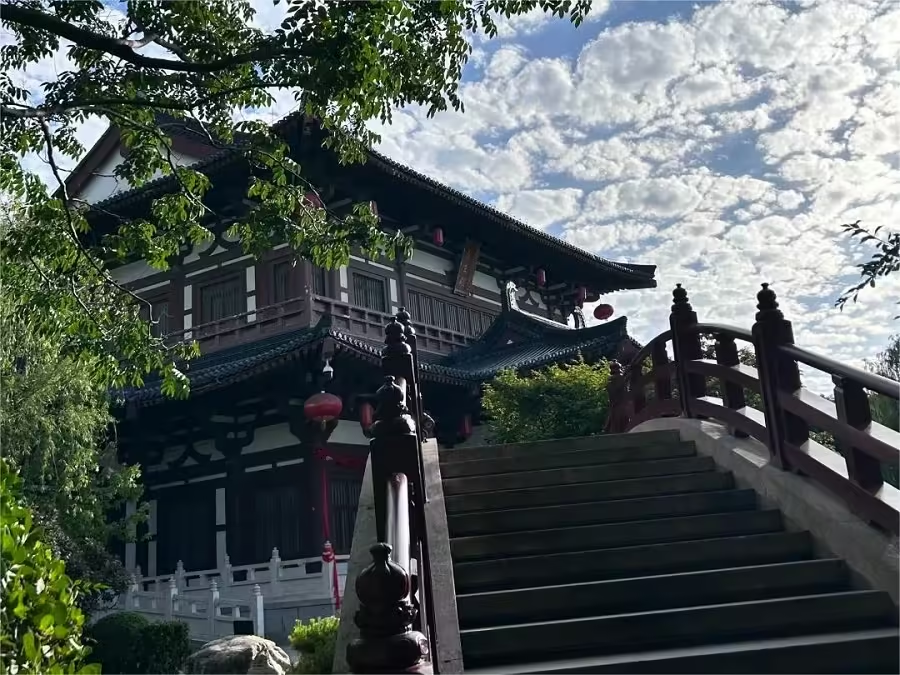
The Five Rooms Hall, located within the Huaqing Pool Scenic Area, earned its name from the five connected single-room halls. Built at the end of the Qing Dynasty, it served as a temporary residence for Empress Dowager Cixi during her escape west in 1900. In 1934, it was renovated to accommodate high-ranking officials.
In October and December 1936, Chiang Kai-shek used the Five Rooms Hall as his headquarters during his second visit to Shaanxi. It was here that the Xi’an Incident unfolded, a pivotal event that shocked both China and the world. The site still bears the bullet marks from the confrontation and features the original furnishings, including desks, chairs, beds, sofas, tea sets, stoves, carpets, and telephones.
On the hillside behind the Five Rooms Hall stands the “Soldier’s Advice Pavilion,” where Chiang Kai-shek sought refuge during the attack on Huaqing Pool. The pavilion is a historical landmark commemorating his escape and subsequent rescue by mountain search teams, who escorted him to Xi’an.
Jiu Long Lake (Nine Dragons Lake)

Jiu Long Lake, located within the Huaqing Palace Scenic Area adjacent to the Furong Lake Scenic Area, is an artificial lake built in 1959. Covering an area of 530 square meters, the lake is divided into two sections—upper and lower—separated by a long embankment known as the Jiu Long Bridge. The bridge features two pavilions: the Morning Sun Pavilion to the west and the Evening Glow Pavilion to the east. These pavilions are mirrored by the Longyin Pavilion on the southern bank of the upper lake.
The Longyin Pavilion is distinguished by its large dragon head that extends downward, from which the spring water flows continuously, earning the pavilion its name. The Jiu Long Bridge, adorned with eight dragon water spouts, combines with the large dragon head beneath the Longyin Pavilion to form the “Nine Dragons,” giving the lake its name. Along the southern and eastern banks of Jiu Long Lake, you will find several Tang-style palaces including the Chenxiang Hall, Feishuang Hall, Yichun Hall, and Yichun Pavilion. The palaces, primarily red in color, are surrounded by green pines, cypress trees, weeping willows, and a shimmering lake, creating a picturesque, fairy-tale-like setting.
Feishuang Hall, with its soaring eaves and green-tiled roof, was the favored residence of Emperor Xuanzong and Yang Guifei during their stays at Huaqing Palace. The emperor and his consort would bathe in Huaqing Pool from October to the end of the year, residing in the enigmatic Feishuang Hall. It is said that in winter, snowflakes often filled the sky, but due to the underground hot springs at Huaqing Palace, the surface temperature remained relatively high, causing the snow to turn into frost. Hence, the hall is named “Feishuang Hall” or “Flying Frost Hall.”
Tang Liyuan Ruins Museum
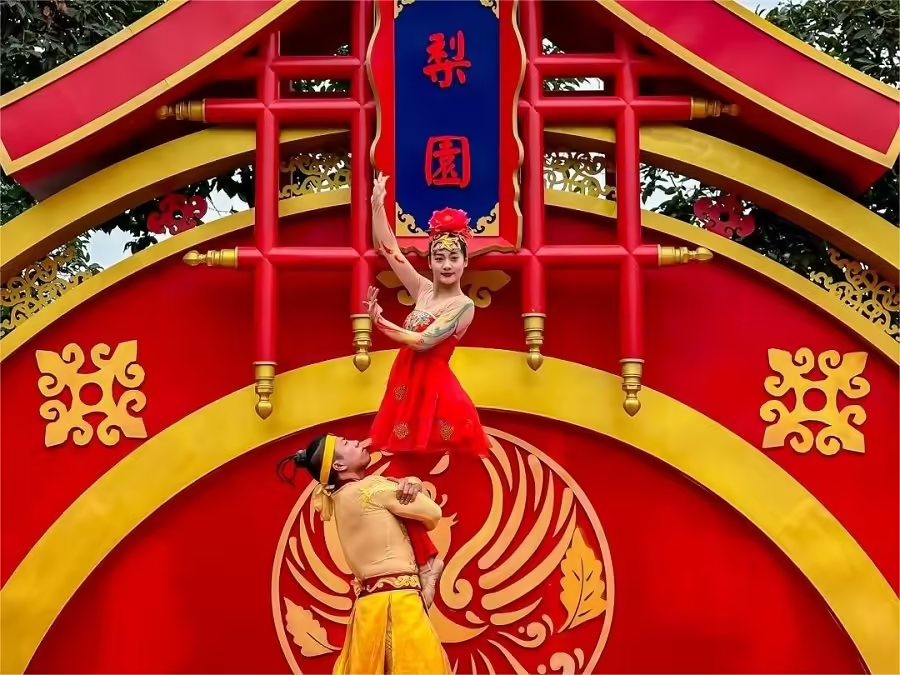
The Tang Liyuan Ruins Museum, discovered during the construction of the Huaqing Pool area in 1994, reveals the architectural remnants of the Tang Dynasty’s imperial theater. After over two years of excavation by archaeologists, it was confirmed that the site is the Tang Dynasty Liyuan (Royal Theater) of Huaqing Palace, where the emperor’s entourage performed and stayed. More than 800 artifacts were unearthed from the site.
Officially opened to the public in 1996, the museum underwent two renovations in 2004 and 2017, becoming the only museum in China dedicated to the Tang Liyuan culture. The museum provides a vivid, comprehensive representation of the Tang Liyuan, showcasing the small pool site and the overall ruins of the Tang Huaqing Palace Liyuan, along with a wide range of unearthed relics. The museum highlights the historical and cultural significance of the Tang Dynasty’s royal entertainment venue.
Natural Hot Spring Pools

The natural hot spring pools are fed by underground springs with temperatures ranging from 36 to 43 degrees Celsius, making them a popular destination for those seeking relaxation and rejuvenation. The water in the pools is rich in minerals and is said to have therapeutic properties that can help alleviate various ailments. There are several pools in the Huaqing Hot Spring Scenic Area, each with its unique features and temperature. Visitors can choose to take a dip in the pools, enjoy the stunning natural scenery around them, or even get a traditional Chinese massage while soaking in the warm waters.
Lishan Mountain Range

Huaqing Hot Spring is located at the northern foot of the Lishan Mountain Range, which is renowned for its natural beauty, with lush forests, waterfalls, and stunning vistas. Visitors can hike up the mountain trails to explore the scenic beauty of the area and enjoy panoramic views of the surrounding landscape. The mountain range is also home to several historic sites, including the Mausoleum of the Yellow Emperor, the Qianling Mausoleum, and the Tomb of Emperor Taizong of Tang.
Tang Dynasty Show

The Tang Dynasty show is a musical and dance performance that showcases the culture and history of the Tang Dynasty, which was one of the most prosperous periods in Chinese history. The show features performers dressed in traditional Tang Dynasty costumes and performing on a stage with intricate backdrops and lighting. It includes classical Chinese music, dance, and acrobatics, and tells the story of Emperor Xuanzong and his beloved concubine Yang Guifei.
Map and Recommended Routes
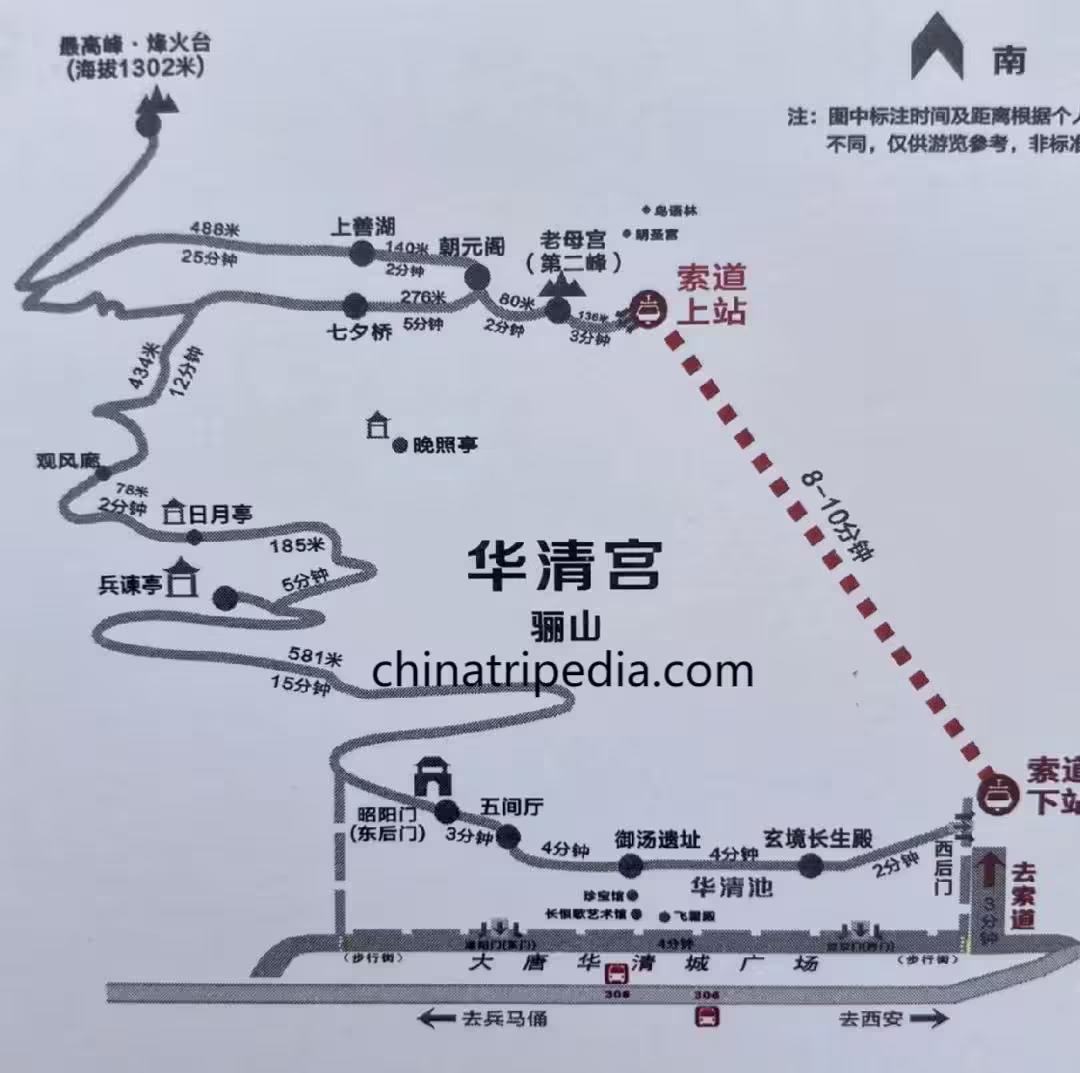
Huaqing Palace offers three distinct routes for visitors to explore its historic and scenic attractions:
West Gate Route:
- Start at the West Gate – Proceed through the Curved Bridge – Visit the Changsheng Hall – Enjoy the view of Jiulong Lake – Explore the Treasure Pavilion – See the Imperial Hot Springs Site – Walk through the Park Area – Reach the Zhaoyang Gate – End at the Bingjian Pavilion.
East Gate Route:
- Start at the East Gate – Visit Jiulong Lake – Explore the Treasure Pavilion – Stroll around Furong Lake – Cross the Curved Bridge – Visit Changsheng Hall – See the Longyin Pavilion – Explore the Imperial Hot Springs Site – Visit Yuwang Hall – Walk through the Park Area – End at the East Back Gate and the Bingjian Pavilion.
Mount Lishan Route:
- Start at the top of Lishan Mountain – Visit the Laomu Hall – Explore the Changsheng Hall Ruins – Stop at Wanzhao Pavilion – Continue to the Bingjian Pavilion – Walk down the mountain to finish your visit
Vlog about Huaqing Hotspring
What to Do at Huaqing Palace
Explore the Tang-style Architecture Around Jiulong Lake:
- Discover a collection of Tang dynasty-inspired buildings, including Feishuang Hall, Yichun Hall, Chenxiang Hall, Jiukou Corridor, Longyin Pavilion, and Longshi Boat. Dressing in traditional Hanfu and taking photos here provides a perfect opportunity to capture stunning memories.
Photograph Changsheng Hall:
- The iconic Changsheng Hall is a must-see, symbolizing the vow of eternal love, “May we be together as a pair of birds in the sky, and as intertwined branches on the ground.” It’s an essential spot for photos and experiencing the historical romance of Huaqing Palace.
Walk Across the Magpie Bridge:
- Stroll across the Magpie Bridge, ideally with a loved one, to enjoy a tranquil moment, breathe fresh air, and savor a slower pace of life. The bridge offers a serene and picturesque setting perfect for a romantic walk.
Relax at Jiukou Corridor:
- Sit and unwind at the Jiukou Corridor, where you can enjoy the fresh mountain breeze of Lishan and the lush greenery around you. The gentle wind and fragrant flowers make for a peaceful retreat.
Visit the Treasure Pavilion:
- Explore the Treasure Pavilion to view an array of historical artifacts, from ancient relics of the Jiangzai site dating back 6,000 years to Chiang Kai-shek’s handwritten manuscripts. This exhibition provides a deep dive into China’s rich historical transformations.
Attend the Immersive Performance of “12.12”:
- Don’t miss the immersive performance of “12.12”, which takes place at the very site of the 1936 Xi’an Incident. This dramatic reenactment transports you back to the critical moment that saved the nation from peril.
Experience the Romance of “The Long Song of Eternal Regret”:
- Enjoy the romantic “Long Song of Eternal Regret” dance drama, a unique cultural experience in Xi’an. Set against the backdrop of Lishan Mountain and illuminated by starlight, this performance tells the tragic and epic love story of Emperor Xuanzong and Yang Guifei from the Tang Dynasty.
Photography Spots and Tips at Huaqing Palace
Changsheng Hall (长生殿):
- Spot: Capture stunning images of Changsheng Hall, which represents the grandeur of the Tang Dynasty. The best vantage point is from beneath the Wangjing Gate, facing the hall. With Jiulong Lake in the foreground and Lishan Mountain in the background, the composition creates a layered and majestic effect.
- Tip: Visit early in the morning or late afternoon for soft lighting and fewer crowds.
Furong Hall (芙蓉殿):
- Spot: For a tranquil and serene photo experience, head to Furong Hall. This spot is less crowded and offers a peaceful environment, ideal for capturing portraits or elegant shots.
- Tip: Bring a wide-angle lens to capture the entire hall and its surroundings, and consider visiting during off-peak hours.
Jiukou Corridor (九曲回廊):
- Spot: The corridor along Jiulong Lake showcases the royal garden’s grandeur. The arched bridge at the end of the corridor leading to Changsheng Hall creates a dramatic and cinematic feel.
- Tip: Use a tripod to stabilize your camera for long-exposure shots that highlight the intricate details of the corridor and bridge.
Longshi Boat (龙石舫):
- Spot: The dragon-shaped stone boat offers unique perspectives. Aerial shots or low-angle photos from the boat can make it blend seamlessly with the surrounding scenery, resembling a beautifully composed painting.
- Tip: Try different angles to find the one that best captures the harmony between the boat and the landscape.
Liyuan Scenic Area (梨园景区):
- Spot: This area is known for its historical significance as the stage for performances by Emperor Xuanzong and Yang Guifei. The scenic backdrop and historical ambiance provide excellent photo opportunities.
- Tip: Look for framing elements such as traditional architecture or natural scenery to enhance the depth and narrative of your photos.
Yutang Ruins (御汤遗址):
- Spot: The Yutang Ruins are famous for the scene described in Bai Juyi’s poem “Song of Everlasting Regret,” depicting Yang Guifei bathing in the hot springs. Photograph the statue of Yang Guifei and the ancient bathing pool.
- Tip: Early morning or late afternoon light will create a soft glow on the ruins, adding a timeless quality to your photos.
Popular Restaurants near Huaqing Palace
Yingying La Tiaozi (迎迎拉条子):
- Location: In the alley of Zhoujiacang, between Huaqing Primary School and the government office, about 300 meters in.
- Overview: A longstanding favorite for local residents. Known for its oil-splashed noodles and fried eggs. The restaurant is very popular during school hours, so arrive early to secure a seat.
- Price: Around 10 RMB per bowl.
- Tip: If you have trouble finding it, use navigation.
Fushunxiang Dapanji (福顺祥大盘鸡) / Tangwu Dapanji (唐武大盘鸡):
- Location: Both are close to Huaqing Palace, with Tangwu being slightly nearer.
- Overview: Fushunxiang is known for its large portions of chicken and has been a local favorite for years. While its quality has reportedly declined, it remains popular and requires advance reservations. Tangwu, also well-regarded, offers similar dishes and was notably popular for its social media promotions.
- Tip: Avoid peak meal times to dodge long waits.
Snack Streets (Xijie Night Market / Xiabei Street / Jiankang Road):
- Overview: These local markets are great for various street foods.
- Xijie Night Market: Best visited in the evening. Highlights include beef noodles, grilled oysters, and squid. The market has changed over the years, but these are reliable favorites.
- Xiabei Street: Ideal for daytime visits, offering a range of options from Hunan-style steamed rice to Xinjiang-style fried rice noodles. Don’t miss the Henan-style spicy soup before noon.
- Tip: Xijie Night Market is a 5-minute walk from Huaqing Palace, while Xiabei Street offers diverse choices for lunch or dinner.
Wangqi Donkey Hoof (王琦驴蹄子) / Dongting Renjia Home-style Restaurant (洞庭人家土菜馆) / Shaoshan Village Hunan Cuisine (韶山村湘菜) / Liu Sanjie Hunan Cuisine (刘三姐湘菜) / Kelaizhou (客来粥到):
- Location: On Jiangzhai South Road, with Kelaizhou being further away.
- Overview: Wangqi specializes in donkey hoof dishes, while the other four offer various home-style and Hunan cuisine. Kelaizhou is known for its porridge but also serves tasty dishes.
- Tip: The first four restaurants are closer to Huaqing Palace. Kelaizhou is good if you’re in the mood for porridge and other dishes.
Useful Tips Summarized from Reviews
Guided Tours: If you have ample time, consider joining a guided tour at Huaqing Palace. Guides can provide insightful information about the historical significance of the site and take you to key attractions such as the Royal Hot Springs relics, hot spring springs, and the site of the Xi’an Incident, where authentic bullet holes are preserved.
Avoid Sightseeing Cars: The sightseeing cars at Huaqing Palace are often regarded as unnecessary expenses. They cover only a short distance, lasting just a few minutes, yet they can be quite costly. It’s recommended to skip the sightseeing cars and walk to most areas of interest on foot to avoid overpaying.
Attend the “Chang’an Impression” Performance: The “Chang’an Impression” performance, also known as the “Song of Everlasting Sorrow,” is a spectacular show that lasts for about 70 minutes. It’s a must-see attraction in Xi’an, offering a captivating portrayal of historical events and cultural elements. Tickets for the performance are in high demand during peak seasons, so it’s advisable to book in advance. The performance offers different ticket categories with varying prices, but the mid-range seats in Zone A offer the best viewing angles and value for money.
Rain Gear for the Performance: If you’re planning to attend the “Chang’an Impression” performance in the evening, you won’t need to purchase rain gear outside. Upon entry, staff members will provide rain gear if needed, ensuring you’re prepared for any unexpected weather conditions during the outdoor performance.





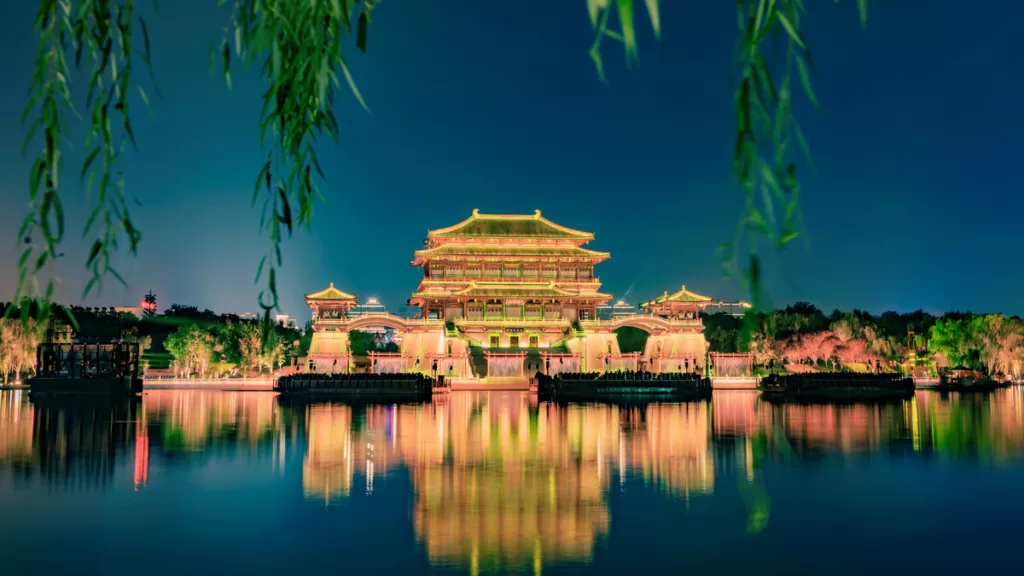
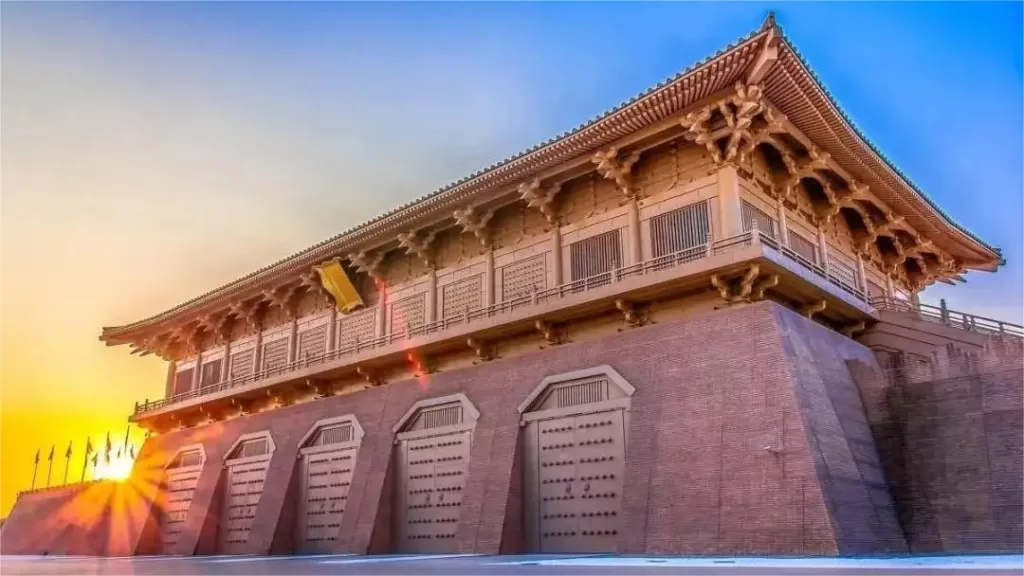


In spring, the Huaqing Pool is breathtakingly beautiful. You can also play games with NPCs from the Tang Dynasty and win prizes. It’s so much fun!
The pool where Yang Yuhuan bathed has no water at all; Huaqing Pool doesn’t seem to hold any historical or cultural significance either.